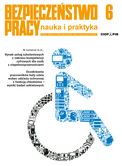Occupational safety during inland shipping – factual and legal state and de lege ferenda remarks
dr inż. Agata Krystosik-Gromadzińska
Occupational safety on ships during inland shipping is a complicated subject due to particular working conditions, quite different from those on land. Depending on the tasks carried out, the size and the technical state of the inland shipping ships,
harmful and onerous factors include noise, vibrations, high or low temperature, as well as limited space of both workplaces and social rooms. The work on the inland shipping ships is also connected with the particular work time distribution.
Since the age of the majority of inland shipping ships in Poland exceeds 50 years, occupational safety is a very serious issue. Working conditions largely rely on the owner’s due diligence and the crew’s sufficient work culture, whereas they should also come from suitable regulations.
The problem is that currently only work time distribution is regulated via legal code in relation to work on inland shipping ships. Since 2002 there have been no detailed regulation concerning occupational safety towards crews of the inland shipping ships. This gap in the Polish regulations seems to be a problem requiring a fast reaction.
Is there a need for market qualifications in OSH? New solutions and opportunities
dr Beata Taradejna-Nawrath
At the end of 2015 The Sejm of the Republic of Poland passed a law on the Integrated Qualification System. The Act of 22 December 2015 on IQS introduced solutions and opportunities for integrating all qualifications obtained within formal and non-formal education, ensuring the quality of granted qualifications, confirming competences acquired outside the education and higher education systems. The question is: there is a need to introduce market-based qualifications in the field of health and safety at work considering new developments and opportunities to acquire professional qualifications. Market qualifications could be applied for by people interested in working in the area of a given qualification, who would show a separate part or all of the learning outcomes required for a given qualification.
The article presents the idea of the Integrated Qualification System and the report from the research on the demand for market qualifications. The survey was conducted in the environment that is most relevant to health and safety at work - employers, OSH specialists and entities operating on the market in this area.
The locomotor system of professionally active nurses – original research
Marta Grześkowiak , dr Łukasz Pawik , mgr Aleksandra Schabowska , dr hab. Felicja Fink-Lwow , dr Malwina Pawik
The work of nurses is associated with exposure to harmful chemical factors and biological agents, as well as overload of the locomotor system, which negatively affects their health. Most nurses suffer from back pains and indicate the link among work and physical health as well as mental health. Pain afflictions note an increase mainly while maintaining long-lasting, forced body positions and during the heave of heavy objects. Insufficient amount of auxiliary equipment and/or its insufficient technical quality, as well as issue in the department of ergonomics, are also possible causes to the heightened risk to the presence of ailments of nurses.
Clothing sets with thermoregulation function for mine rescuers
mgr inż. Krzysztof Łeżak , dr inż. Grażyna Bartkowiak , mgr inż. Agnieszka Greszta , dr inż. Anna Dąbrowska , dr inż. Sylwia Krzemińska , mgr Krzysztof Makowski , dr inż. Magdalena Młynarczyk
Mine rescuers’ work is associated with many extreme hazards, including difficult climatic conditions. At the same time, the clothing and cooling systems that they use are still too ineffective in terms of dissipating excess heat from the body, which sometimes leads to overheating and consequent death of a rescuer due to heat stroke. These factors constituted an impulse to undertake work towards the development of new, effective in terms of cooling and protective properties, clothing sets for mine rescuers.
This publication presents two alternative clothing sets developed in the RESCLO project, made up of outer protective clothing, used along with one of the two underwear variants, ie. underwear with inserts with phase change material (PCM) or underwear with air-fed cooling system from the air receiver. These solutions ensure compatibility with the additional equipment of the rescuer and provide the possibility of ad hoc configuration of clothing sets depending on the conditions of the action and the threats. Laboratory tests have shown that depending on the tested variant, the thermoregulatory solutions used allow for heat dissipation from the rescuer's body at the level of up to 30 W/m2, which will have a positive effect on the safety of mine rescuers during the operation and extend their safe working time in the underground hot environment.





























